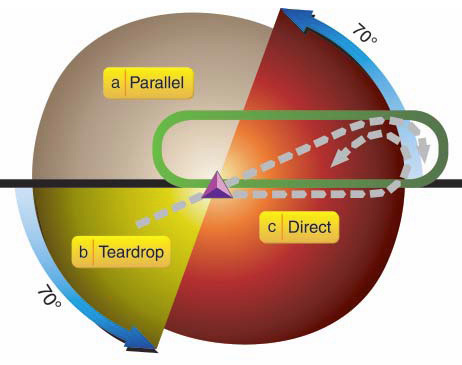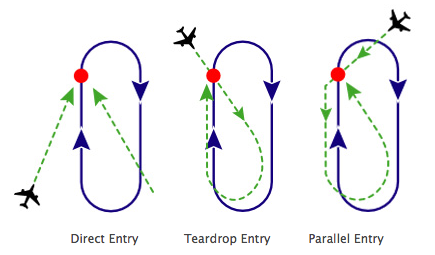Holding Procdures
A hold is ATC's last resort to separate two or more airplanes going to the same place. Often pilots can avoid flying a hold or reduce length of time spent in a hold by slowing down on the way to the holding fix.
Pilots will usually be issued a holding clearance at least 5 minutes before the ETA of a clearance limit or fix. When ATC issues a clearance requiring you to hold at fix where a holding pattern is not charted, you will be issued complete holding instructions. All holding instructions should include an Expect Further Clearance (EFC) time. If you lose 2-way radio, EFC allows you to depart the holding pattern at a definite time.
If you are approaching your clearance limit, and have not received holding instructions from ATC, you are expected to follow certain procedures. First, call ATC and request further clearance before reaching the fix. If you cannot obtain further clearance, you are expected to hold at the fix in compliance with a published holding pattern. If a holding pattern is not charted at the fix, you are expected to hold on the inbound course using right turns.
Holding Speeds
| Altitude | Max Hold Speed |
|---|---|
| Up to 6,000 MSL | 200 KIAS |
| 6,001-14,000 MSL | 230 KIAS |
| Greater than 14,000 MSL | 265 KIAS |
Hold Entries
To determine the proper hold entry:
- Draw the hold around the holding fix (turns are to the right unless otherwise specified by ATC)
- Start with a line perpendicular to the hold through the fix
- Tilt the line 20° towards the holding side to form a 70° angle between the inbound leg and the line you draw
- Check the image below for the type of entry depending on your sector of entry
Hint: When ATC issues your hold instructions, substitute the word "hold" with "outbound". This way you will not confuse the outbound (holding side) of the hold with the inbound leg. Eg, "Hold north on the 360 radial" means your outbound leg will be to the north.

To actually fly the entries:
- Direct - simply turn to the outbound heading upon crossing the fix
- Teardrop - upon crossing the fix, turn toward the holding side 30°, fly one minute, then turn back the opposite direction more than 180° and intercept the inbound leg
- Parallel - Cross the fix and fly the reciprocal heading of the inbound leg for 1 minute, then turn toward the hold side approximately 270° and intercept the inbound leg
As a general rule, the correct entry procedure is the one where you need to turn least at the holding fix.

Once established in the hold, follow the following steps:
- Cross the inbound fix
- Turn at a standard rate towards the outbound leg
- Start timing outbound leg over or abeam the fix, whichever occurs later. If abeam position cannot be determined, start timing when turn to outbound is complete (wings level).
- Fly outbound for one minute*, then turn back to the inbound leg and intercept it
- Time the inbound leg in order to adjust the next outbound leg if it differs from one minute
*The timing of the outbound leg begins over or abeam the fix, whichever occurs later. If abeam position cannot be determined, start timing when turn to outbound is complete (wings level).
There are two primary considerations to adjust on the next outbound leg of the hold:
1. The crab angle to compensate for the wind, which you base upon your previous inbound interception results
2. The time for your last inbound leg - if less than or more than one minute, you must adjust your outbound leg accordingly
Common Mistakes
- Failing to identify proper holding fix
- Failing to identify the proper hold entry
- Forgetting to reduce power for the hold
- Improper wind correction
- Leveling wings during outbound at improper time
- Forgetting to check the EFC time
Practical Test Standards
- Altitude +/- 100 feet
- Heading +/- 10°
- Airspeed +/- 10 knots
- CDI within 3/4 scale deflection
- Appropriate wind correction